Note: See glossary for meaning of terms marked in bold below.
Just getting to Likir and back was a mild adventure where we ran into multiple obstacles. But we happened to be there at the right time to witness the rituals in a special puja.
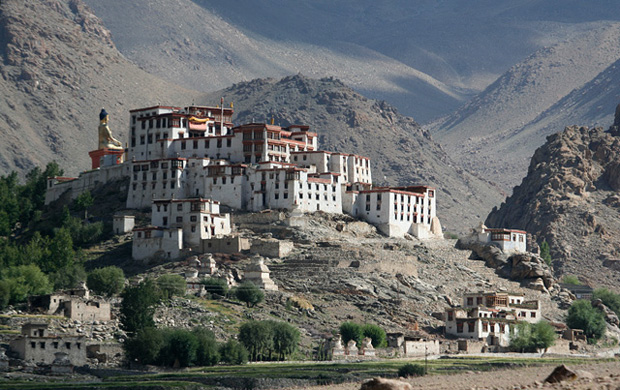
We got caught in high speed winds as soon as we left Leh in a rented two-wheeler. It seemed like a passing thing at first, but the strong winds kept our company for the next fifteen minutes. It was never too strong and threatening enough to blow us away, but had the strength to throw every bit of dust and dirt towards us. It was a tortuous ride against the wind, allowing me to go at speeds no more than ten to fifteen kilometers per hour. In a small stretch where we had to drive close to Indus, the gale lifted the river’s waters and splashed on us generously with great force.
Worried and stuck in the middle of the storm, I looked around for alarmed people who would be searching for a shelter. A jeep passed in the opposite direction, their occupants looking so calm as though they did not notice anything abnormal. A man riding a scooter came from behind and did not appear troubled either. ‘This must be normal,’ I told myself, and let go of the thoughts of searching for a shelter or thinking of heading back.
It was late evening before we approached the mountains near Likir, riding past the confluence of Indus and Zanskar in Nyemo (also written as Nimmu, Nimu, Nimo, Nimmo and every other possibility you can arrive at, keeping N in the beginning and m as the next consonant!) and the precariously perched Basgo Monastery. We missed our turn to Likir, as the only sign at the fork advertised a guesthouse and gave away no other information. Treading an extra five kilometers and realizing the folly after arriving at Saspol Village, we headed back and turned into the right track to arrive at Likir in darkness.
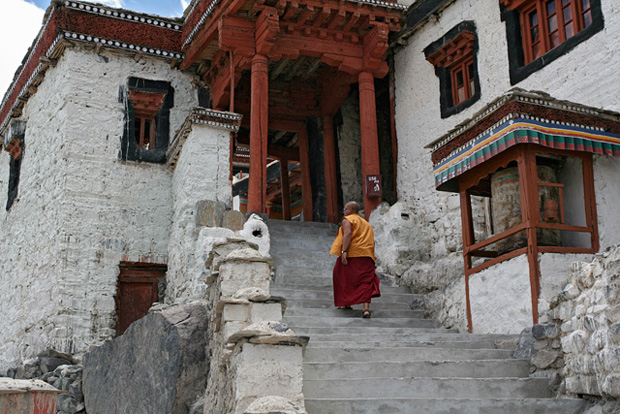
Next morning, we left the bike behind and walked through the village and its barley fields to the monastery at the far end of the village. What seemed to be a short walk stretched longer and longer in the hot sun, tiring my unprepared mind and body. Likir Monastery is a cluttered assembly of buildings surrounded by willow trees on a crag. A stream runs at the base of the crag, originating from the taller ica-capped mountains beyond the monastery. At a corner of the monastery is a tall statue of Buddha that shines brightly in the sun.
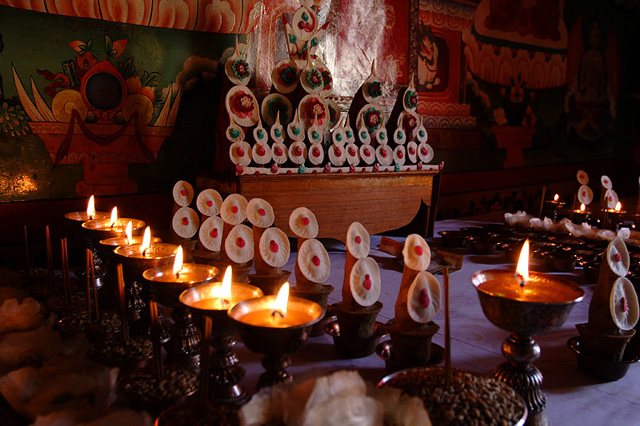
The monastery looked empty at first, until I saw the dukhang filled with ochre robed monks of all ages getting ready for a special puja to install a Yamantaka Mandala. The prayer hall was decorated with lines of torma and oil lamps for the puja. The puja was elaborate process, with all the monks gathered in dukhang and chanting together for a few hours. They begin with their regular ochre robe, slipping in another layer of cloth a little later. An ornate headgear gets added soon, which gets replaced later with the traditional yellow-hat of the drukpa lineage. Chanting continues all through, accompanied with hand movements making various mudras and gestures. The puja is finally concluded by returning to their original robes.
While all this goes on, the little monks sitting in a separate row behave the way kids should be. Some naughty kids begin play-fight with neighbours. Some of them look bored and lost in a world of dreams. One of the brats gets up in the middle and requests to be excused, but he is gently ordered to get back to his seat.

Back from the monastery in the evening, the adventures of the journey continued as we discovered that the bike’s rear tyre is punctured. The attempt to get the punctured bike back to Leh deserves another chapter altogether.
Information
The monastery at Likir is among the best maintained monasteries in Ladakh. One of the special features of the monastery is the 3-storey high statue of Buddha.
How to reach. Likir is about 50km from Leh. You can hire cabs in Leh to take you there. It should be possible to combine your visit to Likir with Alchi. If you have the time, visit the confluence of Indus and Zanskar at Nyemo on the way. Another worthwhile stopover is the fort and monastery at Basgo, which falls on the way. Public transport is available from Leh to Likir. But inquire in advance, as the buses may leave you at the village, which is an hour’s walk from the monastery.
Food and accommodation. There are many guesthouses spread along the village of Likir, but most of them are about 30 to 60 minutes walk from the monastery. Options for food are limited but available. Most guesthouses cater to their occupants.
Map and driving directions
View Leh to Likir in a larger map
I went to Alchi Monastery looking for the ancient paintings of a distinct style that sets it apart from other religious centers in Ladakh. Trees laden with apricots and the swift flowing Indus River were an added bonus.
My bus passed through lush green oasis of saspol village on its way to Alchi. After two hours on the road west of Leh along the Indus River, the bare mountainscape temporarily made way for a relatively flat terrain teeming with apricots and apples amidst barley fields. The apricots trees with numerous fruits looked more yellow than green. Apple trees were irresistibly red.
Just across the river, Alchi Village has one of the oldest standing structures anywhere in Ladakh. The Alchi choskor or the ‘religious enclave’ is dated approximately to eleventh century and has an architecture very unlike other monasteries in the region. It was abandoned as a place of worship and remained unknown to rest of the world, till historians unearthed the treasured paintings in the choskor only a few decades ago. On hindsight, its desertion seems to have worked well in its preservation. The monastery escaped destruction from Kashmiri invaders four centuries years ago as much as it escaped renovation and restoration from the Ladakhi monks.
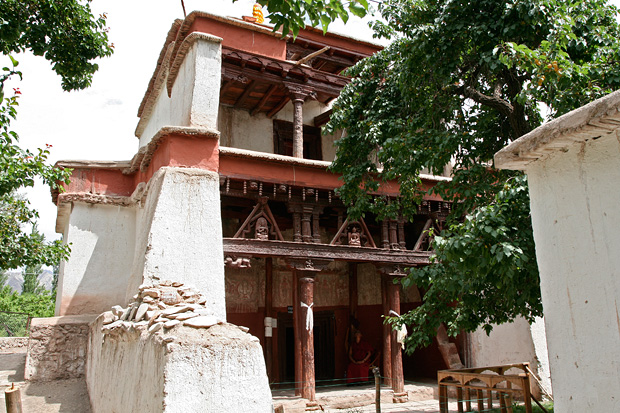
Sum Tsek at Alchi Monastery
Walking past the small village and along a narrow path on the banks of Indus, I entered the monastery that wore a deserted look. It did not have the usual buzz of playful kid-monks running along the corridor chasing each other or the smiling elderly lamas in ochre robes walking slowly as they chanted some mantra. Also missing were the randomly built living quarters that usually spread around the prayer hall, the quadrangle where the festivals are held and the colourful paintings on the front walls. The choskor looked more like a bunch of randomly built houses with a few apricot trees surrounding them.
The drab exteriors though, are a contrast to the colourful inner walls. Once inside, I see every inch of the wall covered with small paintings. The sum-tsek—the main temple in Alchi—is a three story building with colourful paintings in its inner walls. It takes some time to get used to the interiors kept dark to preserve the paintings. The colours start coming alive as the eyes slowly get accustomed to the darkness. The walls are covered from end to end with thousands of small colourful images of Buddha. At the center of three inner walls are three-story high statues of incarnations of Buddha—Avalokiteshwara, Maitreya and Manjushree. The upper half of the Buddha statues are not visible from below, as they stand above the first floor where the weakening structure doesn’t permit access.
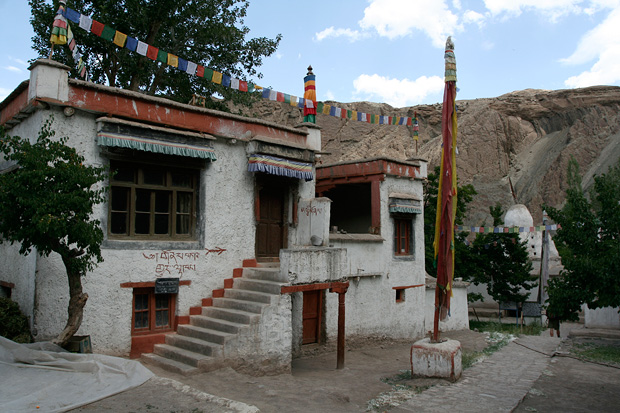
A section of the monastery
At the neighbouring prayer hall are equally colourful but a diverse variety of paintings that include a sailing ship, people wearing clothes that look Central Asian and other secular images that are evidently not Ladakhi. The paintings in Alchi vary considerably from other monasteries influenced by Tibetan culture and its animist origins. It doesn’t carry the extraordinary characters and stylization with demonic and unearthly features commonly seen on the walls of most other monasteries. On the contrary, they are said to bear resemblance to Buddhist paintings from the Indian plains, indicating that Alchi was perhaps built in a time when a wave of Buddhist preachings spread into Ladakh from Kashmir and North India. Historians often refer to this as ‘second spreading of Buddhism’ against the first arrival of the religion in Ladakh from Tibet. Among the Himalayan Buddhist centers, only other surviving monastery with paintings similar to Alchi are found in Tabo Village in Lahaul and Spiti. Both monasteries are now in the tentative list of UNESCO World Heritage sites.
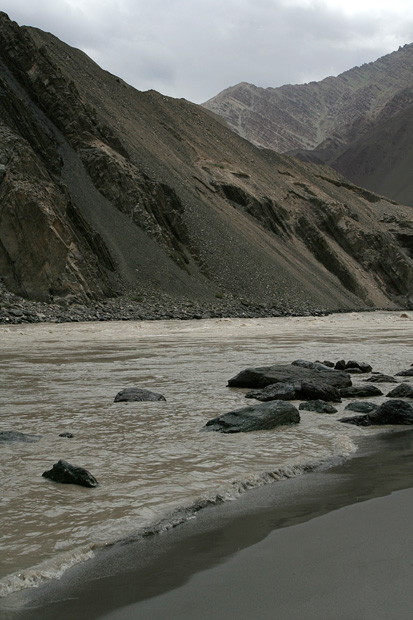
Just outside the monastery, Indus River flows swiftly in a depression carved by its currents. I walked down to the river bank and spent some time watching its fast flowing muddy current before making my way back to Leh in the evening.
Information
The Alchi choskor complex has five buildings. The sum-stek or the three story temple has three-story high statues of Avalokiteshwara, Maitreya and Manjushree, with its walls painted with thousands of small Buddhas. The dukhang or the main prayer hall is larger with two sections and has many secular and religious paintings. The Manjushri Lhakhang, Lotsawa Lhakhang and Lhakhang Soma are the smaller temples.
Alchi Monastery is known for the historical value and uniqueness of the paintings. It is no longer in use as a religious place, though it is maintained and managed by the monks of nearby Likir Monastery.
How to reach. Alchi is 65km from Leh downstream Indus. Most tourists hire a cab to get there, though Alchi is well connected by public transport from Leh (about 3 hours). If you are taking a bus from Leh, it is better to be informed about the timings beforehand. Ask your hosts in Leh or check at the bus-stand a day before.
Food and Accommodation. If you are on a day-trip from Leh, Alchi Village has a few restaurants just outside the monastery. In front of the the choskor is a place run by Likir Monastery, where food and accommodation is available. There are a few more guesthouses and hotels available in Alchi for those who would like to stay at the village.
Map and driving directions.
View Leh to Alchi in a larger map
See glossary for meaning of terms marked in bold below.
How can a photographer assume rights to treat a human being like an inanimate exhibit? It is hard for me to conceive stepping right into someone’s personal space with a big mean digital SLR and shoot a few hundred images using a long lens poking up to the nose of the person being photographed. As if that is not bad enough, the photographer never spoke a word. No smile, not even a hello. Instead, he went on clicking as though he was shooting a sheep, or even worse, a museum piece. He took his time to take pictures from various angles and went satisfied only after every inch of his subject was photographed.
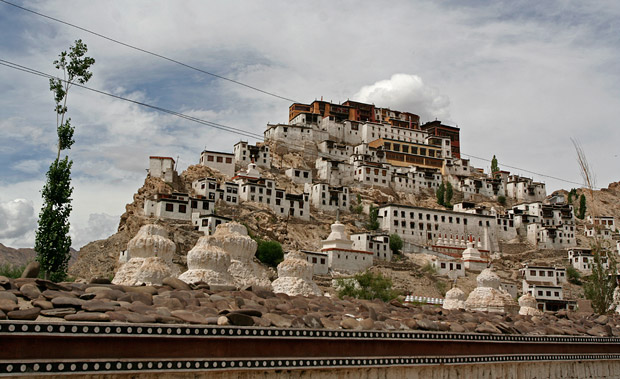
Yet, lama Sherap did not seem annoyed. He did not even blink at the photographer or showed the slightest discomfort. He simply continued at his work and once in a while looked up and smiled. He wasn’t perturbed even when the smile did not result in a reciprocation. After the mean photographer left without saying a ‘thank you,’ he looked at me and smiled as if telling me not to bother. I was sitting there talking with lama Sherap for a while and was very annoyed by the photographer’s behaviour. But the lama himself seemed to live up to what they learn – he was perfectly composed and simply resumed his work as though nothing happened.
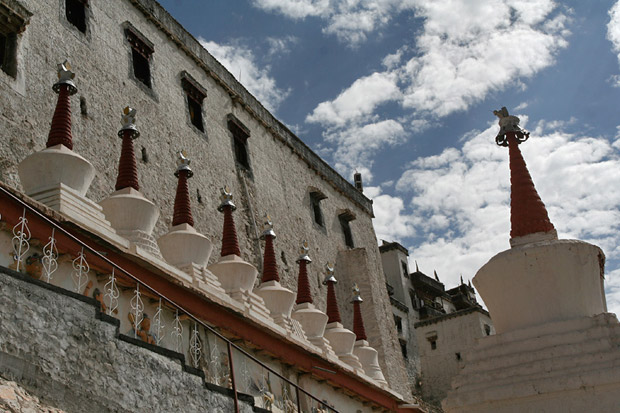
Lama Sherap was taking care of the du-khang that day. He was alone in the prayer hall as his companions had gone to the village to perform some rituals. He was friendly, approachable and smiled gently every time he spoke. Sitting on the floor close to the entrance of the hall, he busied himself kneading chunks of tsampa (barley flour) and preparing torma. He explained me what torma is and helpfully added that it is for some special prayers being performed tomorrow.
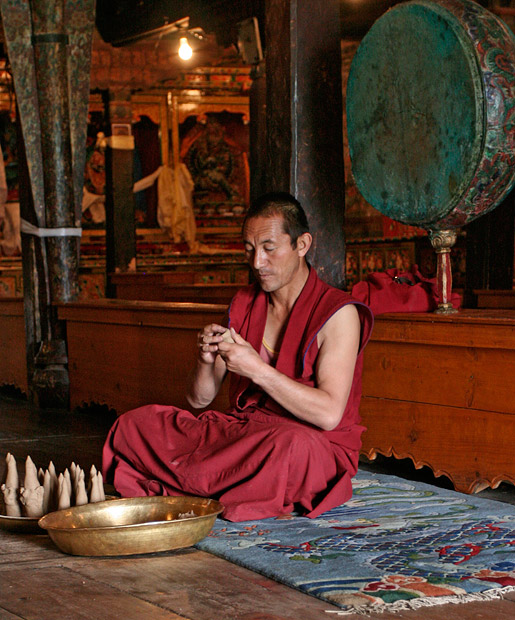
As I sat and talked to with him, a Ladakhi woman walked in, greeted the lama with a smile and a ‘julley’, prostrated repeatedly towards the altar and and left as quickly as she came. Tourists kept coming in packs, took pictures and left within minutes, having ticked Thiksey off their list. After the nosy photographer completed his work, lama Sherap asked me how a digital camera works.
‘Today’s cameras don’t have film rolls and you can see the pictures at the back of them,’ he said, ‘where do the photos get recorded?’ I took out the CF card from my camera and showed him in answer. His next questions came immediately.
“How may photos get stored on them? They could get 36 in a roll of film. In which country do they make these things?”
After satisfying his curiosity, it was my turn to ask questions. Lama Sherap showed me a statue of Tson-ka-pa, helpfully identified it for me and explained that the monastery belongs to Gelugpa order. ‘There are about a hundred lamas,’ he said, ‘some are young lads and some are more than forty years old.’
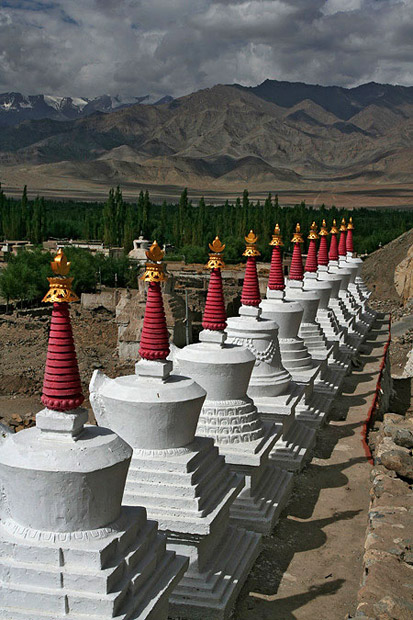
As long as I was with him, he never saw his smile go away. When tourists misbehaved, sitting on the carpets that were meant only for lamas, he would wait to see if they would rise soon and then offer them another seat. There was not the slightest hint of irritation or anger despite repeated violation of regulations by visitors. Later at chon-kor, the room with a large idol of Buddha Maitreya, I saw a visitor stumble and drop a lamp on the floor and guiltily look at the monk taking care of the room, only to see him smiling. What could be an embarrassing moment was instantly dissolved in those smiles.
The chon-kor has an impressive 2-storey high statue of Buddha Maitreya. The tall Maitreya sits in padamasana (lotus position) and has a calm unblemished face. His lotus-like crown is embellished with images of reincarnations of Buddha. His large ornate ear rings complement the crown and stand out against the turquoise outfit.
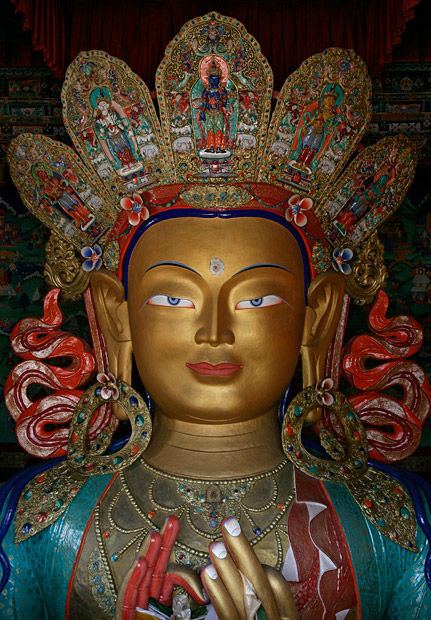
The Maitreya statue is relatively new, inaugurated in 1980 by Dalai Lama. The monastery itself was founded in early 15th century. Walking up the crag where a group of haphazardly built buildings of the monastery are located, it is evident that the institution has grown and expanded over the years. I climb up the steps leading to the monastery past a latest addition – a newly built row of chortens.
Inside, the du-khang seems to be old enough to be one of the first buildings built. To each side of its entrance are the colourful murals of the deities of the four directions, while inside walls are painted with various forms of Buddha and Yab Yum. At the rear side of du-khang is a small chapel with metallic statues of Tson-ka-pa and Manjushri.
The paintings on the outer walls have a curious diversion from tradition. The samsara-chakra has figures wielding guns and wearing clothes more suited for British and Indian men of the plains a few hundred years ago.
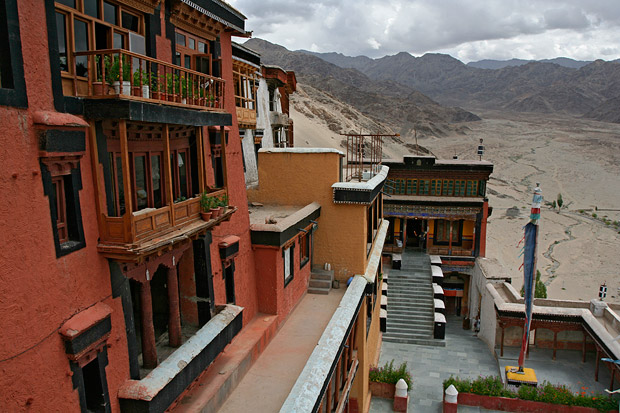
The stairs next to the du-khang lead to the terrace from where I can see the barley fields spread along the valley, the river coiling through the fields and the mountains beyond. In the corner of the terrace is a small room – a library filled with ancient Tibetan scriptures. As I descend from the stairs and head out to the valley, it is the smiles of Lama Sherap and the calm face of Maitreya that stay in my memory, etched stronger than the photographs I clicked in the monastery.












